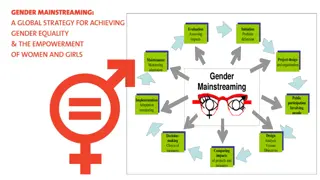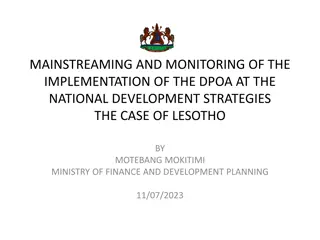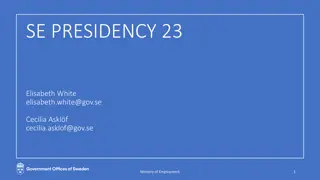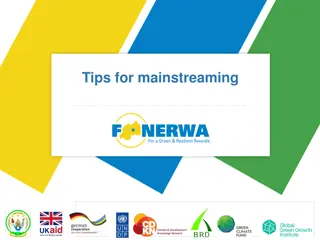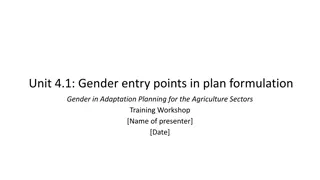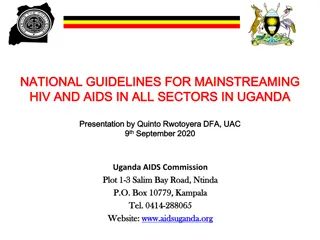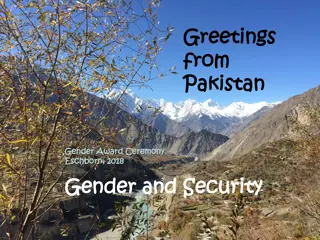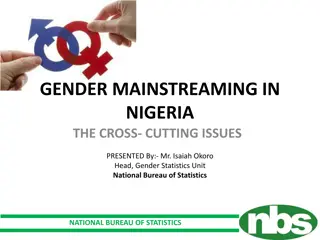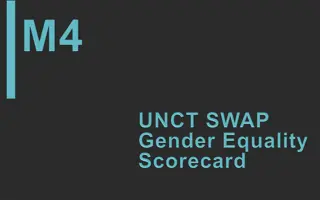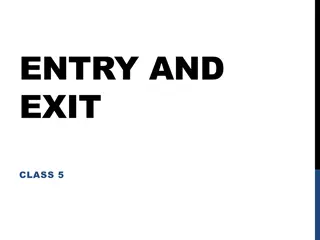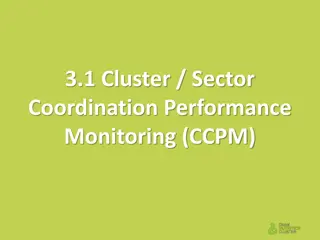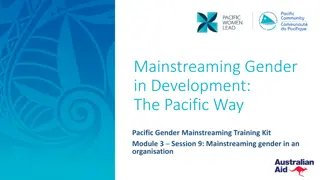Gender Mainstreaming in UNSDCF Cycle: Entry Points and Actions
Learn how to identify the entry points for gender mainstreaming in the UNSDCF cycle and take appropriate actions to ensure gender integration. Discover resources and seize the momentum for gender inclusion. Utilize the UNCT SWAP Gender Equality Scorecard to promote gender responsiveness in UNSDCF engagements. Implement the insights from the training in developing a gender-responsive UNSDCF Analysis.
Download Presentation

Please find below an Image/Link to download the presentation.
The content on the website is provided AS IS for your information and personal use only. It may not be sold, licensed, or shared on other websites without obtaining consent from the author.If you encounter any issues during the download, it is possible that the publisher has removed the file from their server.
You are allowed to download the files provided on this website for personal or commercial use, subject to the condition that they are used lawfully. All files are the property of their respective owners.
The content on the website is provided AS IS for your information and personal use only. It may not be sold, licensed, or shared on other websites without obtaining consent from the author.
E N D
Presentation Transcript
Module Objectives Identify the entry points for gender mainstreaming in the UNSDCF cycle and actions to be taken; Draw on all the resources presented and leverage on the momentum for the integration of gender in their context; Harness the potential of the UNCT SWAP Gender Equality Scorecard to ensure a gender-responsive UNSDCF engagement; Directly apply the inputs and considerations made during the training when developing the UNSDCF M4|Gender-responsive UNSDCF - Analysis
Gender-responsive UNSDCF Implementation Results Analysis Development of the Cooperation Framework Gender analysis of key national development plans Gender Equality Profile (sex disaggregated data and analysis) Conflict analysis (as appropriate) Inclusive participation of CSO (LNOB) Gender mainstreaming in joint work plans and joint programmes Funding Framework and SDG Financing Strategy UN Women collaborative advantage and gender expertise Mainstreaming Gender in ToC, CF outcomes/outp uts/indicators Agency Specific- Documents UNCT SWAP Score Card Feedback Loop into new cycle BPFA+25 national reports Thematic KP, research reports, qualitative data, etc. Flagship reports (Progress, etc.) Regular follow up on the management response to evaluation Guidance and expertise on gender sensitive evaluation and management response M4|Gender-responsive UNSDCF - Analysis
Entry Points UNSDCF Process GEWE Actions Common Country Analysis Gender Analysis Engender the Theory of Change Theory of Change Gender-responsive Outputs, Outcomes, Indicators UNSCF Development Results Programme on Gender M4|Gender-responsive UNSDCF - Analysis
ANALYSIS M4|Gender-responsive UNSDCF - Analysis
Minimum Actions Identify gender expertise to integrate a gender perspective in the analysis and engage all relevant stakeholders, including women and girls, in open, inclusive, participatory, and transparent analytical processes; Identify the human rights standards, and relevant international obligations and commitments made by the country on gender and progress therein; M4|Gender-responsive UNSDCF - Analysis
Minimum Actions ctd. Identify patterns of discrimination and inequality, including among different groups of men and women, the underlying causes of gender inequalities; Regularly collect data on gender-specific indicators, and promote the increase development and use of gender statistics; Analyse how various forms of structural inequality intersect and compound gender-based inequalities as relevant for the formulation of strategies addressing women and girls who are consistently among the most disadvantaged; M4|Gender-responsive UNSDCF - Analysis
Minimum Actions ctd. Ensure the systematic engagementwith women s groups and National Women s machineries during the Common Country Analysis. [indicator 3.2 UNCT-SWAP Gender Equality Scorecard] Ensure that context-based gender analysis informs the CCA, drawing on gender-sensitive data and evidence, and including analysis of the underlying and structural causes of gender inequality and discrimination. [indicator 1.1, UNCT-SWAP Gender Equality Scorecard] M4|Gender-responsive UNSDCF - Analysis
Contents of a gender analysis Human Rights Frameworks: Use of CEDAW, the Universal Periodic Review (UPR) and other international human rights instruments and their reporting mechanisms. Intersectionality: information that analyses the relationship between ethnicity, culture, income level, age, sexuality, gender or gender identity, disability and any other conditions, to understand the different patterns of participation, behaviors and activities carried out by women and men in the economic, social, political and legal structures of the country. Underlying and structural causes, including the dynamics of the power relations between women and men, access to resources and its control of by both. Rights approach: Analysis of roles and capacities (rights holders and duty bearers) against the problems identified in the analysis. M4|Gender-responsive UNSDCF - Analysis
Possible questions for the analysis Those who are being affected by gender inequalities (women are not a homogeneous group). In which parts of the country? What is the evolution over time? How do different forms of inequality, marginalization and vulnerability intersect? Which groups of women are most at risk of being left behind? Is disaggregated data by sex and other variables available for diagnosing and analyzing structural causes being used? Have reports prepared by NGOs been consulted in addition to the official reports? Are the specific commitments that exist in relation to the gender inequalities identified in international and regional regulatory frameworks as well as related national laws mentioned? M4|Gender-responsive UNSDCF - Analysis
Data sources National data repositories: INE, Health Ministries, Education, CIEDEJ Regional and international data: (e.g. UN Women Global and Regional Reports/GenderStats/World Bank/ECLAC/Inter-Parliamentary Union/FAO Gender and Land Rights Database, etc.) Government laws, policies and regulations General articles and recommendations of CEDAW and other bodies established under human rights treaties and special procedures (e.g. reports of a Special Rapporteur). UN and UN agency reports. International, regional and national surveys. Academic research and national and international media. Qualitative data sources; ethnographic information about cultural and religious traditions and beliefs. M4|Gender-responsive UNSDCF - Analysis
Data quality Accurate? Comparable? Complete? Adequate? Objetive? Triangulated? Valid sample? Importance of data desegregated by sex, age, disability, ethnic group, socioeconomic status and other variables M4|Gender-responsive UNSDCF - Analysis
Group work M4|Gender-responsive UNSDCF - Analysis
Questions? Photo credit: www.flickr.com M4|Gender-responsive UNSDCF - Analysis



